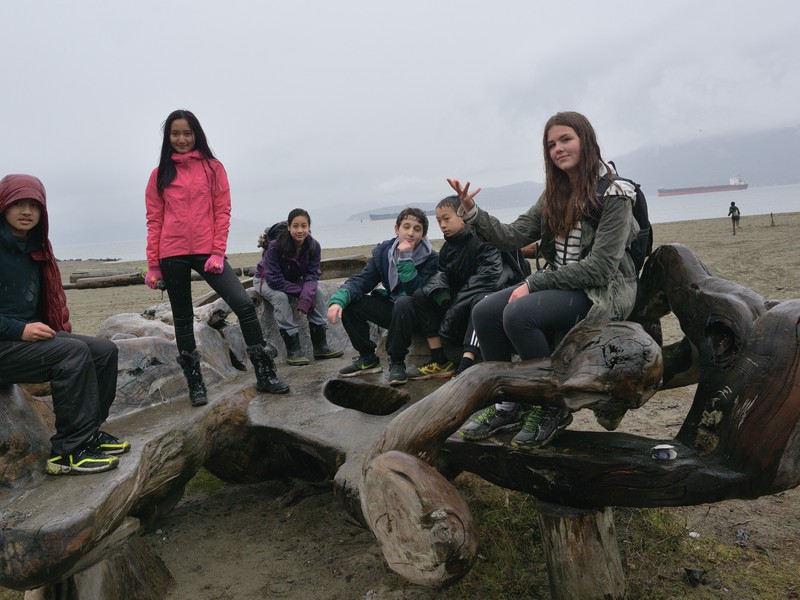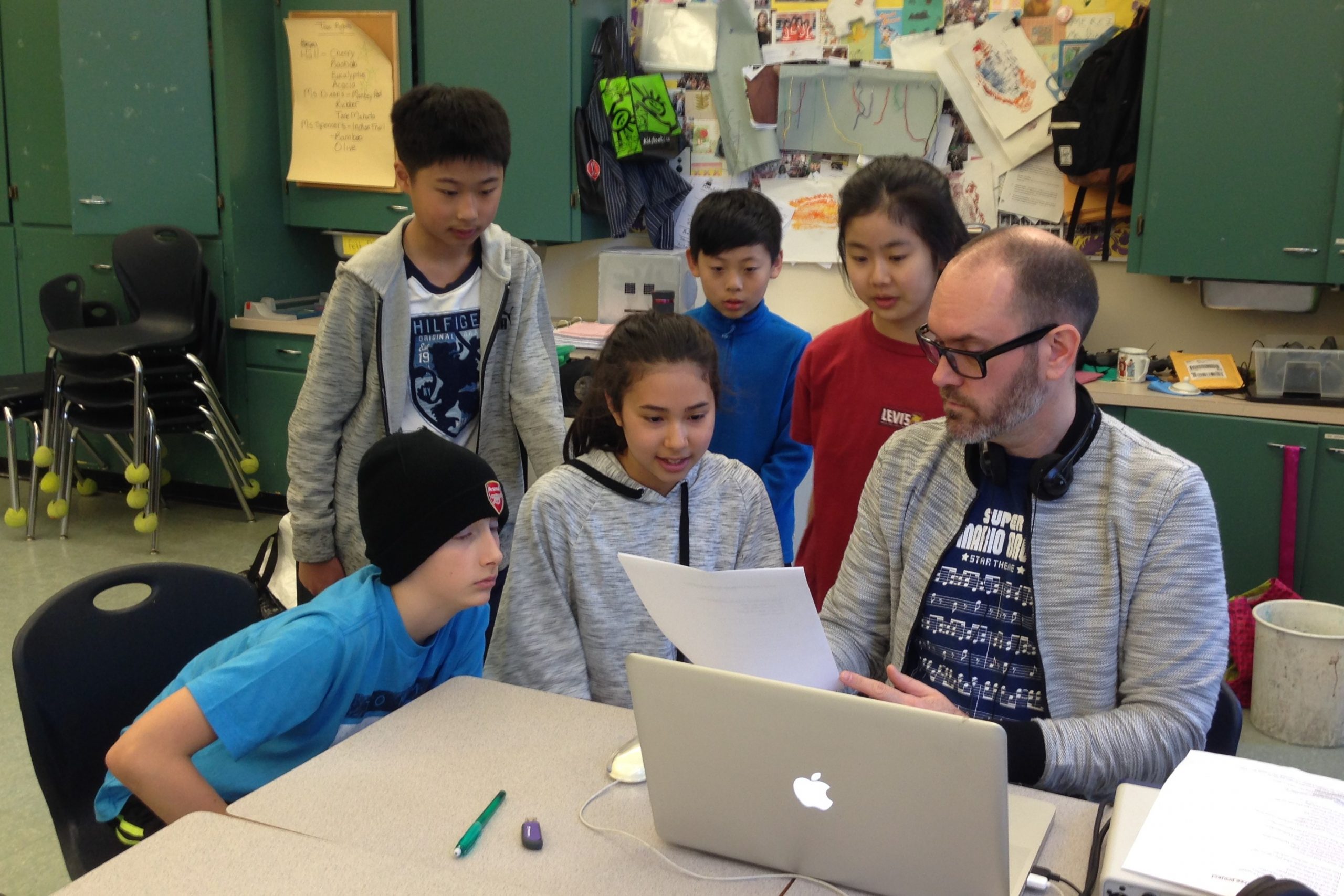Kerrisdale Elementary: Trees Transforming
Arts Education, Health and Career Education, Language Arts, Science, Social Studies
School: Kerrisdale Elementary School
Teacher: Jane Spencer, Alison Dixon
Artist Collaborators: Gordon Cobb
Class: Grade 6/7
Overview
This BIG IDEAS project is part of a year-long unit of study at Kerrisdale Elementary School. Students began their inquiry by learning about different tree species. They used their new knowledge as a starting point for their artistic and intellectual production, which incorporated themes of globalization, community and environmental stewardship, and community participation and collaboration. Students were encouraged to look at the environment in which they live, examine how they shape and are shaped by it, and resolve to participate in the conversation about its future. Students also examined how their citizenship and artistic practice contribute to their vision of the world, and how to participate in globalizing practices in a collaborative, community-oriented way.
Connection to the Vancouver Biennale Exhibition
Students visited Public Furniture/ Urban Trees by Hugo Franca in the spring to inspire questions about art, trees, and the transference of ideas and understanding across cultures. The beauty of the work, inspired by nature, catalyses appreciation for natural resources, inquiry about differences and similarities in the natural environments and cultural production of different countries, and discussion of how art can express common values across cultures to influence our vision of the future.
BIG IDEAS
Engaging in creative expression and experiences expands people’s sense of identity and community.
Experiencing art is a means to develop empathy for others’ perspectives and experiences.
Artistic expressions differ across time and place.
Through art making, one’s sense of identity and community continually evolves.
Dance, drama, music, and visual arts are each unique languages for creating and communicating.
Experiencing art challenges our point of view and expands our understanding of others.
Engaging in the arts develops people’s ability to understand and express complex ideas.
Guiding Questions
How have trees shaped our environment, and how do they fit into the process of globalization?
Topics for student projects:
How trees help us to meet basic needs.
How trees were regarded by First Nation cultures.
The impact of logging on our environment and economy.
Urban trees as oxygen providers.
Trees as inspiration for art.
Cross-Curricular Access
Socials Studies – Big Ideas
- Complex global problems require international cooperation to make difficult choices for the future.
- Media sources impact our understanding of events and issues.
- Geographic conditions shaped the emergence of civilization.
- Economic specialization and trade networks can lead to conflict and cooperation between societies.
Social Studies – Content
- Human responses to particular geographic challenges and opportunities, including climates, landforms, and natural resources.
- Features and characteristics of civilizations and factors that lead to their rise and fall
Math – Big Ideas
- We can apply mathematics to inquiry questions and use it to communicate information and data.
General Cross-Curricular Activity:
Science: Students explored and interpreted the local environment, identified relationships and survival needs
within the ecosystem, and identified the contributions of trees.
Language Arts: Students explored persuasive techniques, literary devices, text features and many forms of media. They synthesized meaning from different texts and ideas in order to create new understandings, and to use language and text as a source of creativity and joy.
Learning Process and Student Creation
Autumn 2016
Establishment of regular yoga and mindfulness practices in the classroom
Teacher-student discussion: How do you cultivate an open-minded learning culture and foster student engagement in the classroom?
Outdoor activities such as bike trips in the Endowment Lands and meditation walks in Vandusen Gardens.
Study of trees and ecosystems in Science.
Leaf sketches and tree portraits in art.
Analysis of the poem “Advice from a Tree”.
January 2017
Creation of inquiry questions to drive student research on the contribution of trees to globalization.
March 2017
Initial visit to Public Furniture/Urban Trees in order to practice experiencing, describing, analyzing and interpreting the piece.
Student exploration of media literacy and digital technology.
Student study of and practice with the elements of art and principles of design.
Creation of stories or poems about trees from four continents.
April and May 2017
Student collaboration with Biennale artist to create songs based on their earlier artistic and literary production.
June 2017
Students created four videos documenting their exploration of the role of trees in the process of globalization.Student visit by bike to Public Furniture/Urban Trees to see how understanding has changed. Students will reconnect to nature, the environment, and each other through a scavenger hunt.
The final project resulted in a four-part media presentation with a sound track of student voices, which will be viewed school-wide during the Kerrisdale Elementary Art Show.
As students are engaged with the creation of this project, they also learned how they can have a voice in their community through the Student Vote program for the provincial election where their artistic endeavours reflect their values as citizens.
Reflection
Artist – Gordon Cobb
Working with Alison and Jane at Kerrisdale Elementary this year was an incredible experience. Building on our experiences from last year’s Biennale project, a number of enhancements were made in order to centre the process more around the needs of the students. For example, Alison and Jane separated the 60 students up into more groups with fewer students in each group, ensuring that all students would be engaged within the writing and production process. Last year we recorded a total of four songs and this year we produced ten songs. Instead of working with four groups of fifteen students, I worked with ten groups of six students. This created more work for me as the producer and editor of the songs, but overall the experience was much more engaging for the students.
Alison is incredibly organized and a joy to work with. She works as hard (possibly harder) than the students and ensures that every step of the production process is on track and ready to go for each of my sessions with the students. Her exceptional organizational skills are no doubt responsible for the prolific output from these two classes of students. Producing ten songs within a five-class schedule is usually not possible but Alison ensures success by managing the projects like a pro.
Creatively, the students really thrived this year. Students created music in a variety of genres and the students were willingness to take risks and try new things. The collection of music compositions that we created together are really impressive and I couldn’t be more proud of these young music artists.
This project was an incredible success and the students were prolific and inspired. As an educator I couldn’t ask for more!
Credits
Learning case prepared by Mia Mushinski, UBC 2017 Teacher Candidate in collaboration with project teachers and artist collaborator



